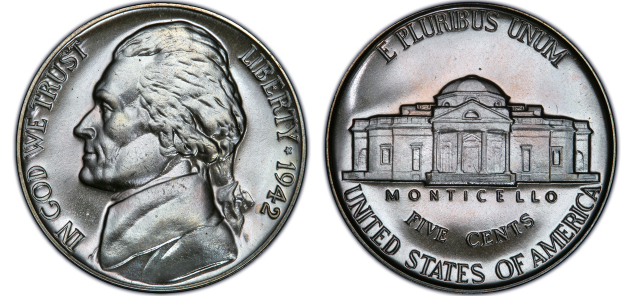1942 Nickel No Mintmark: Values & Strange History Explained
There were four different nickels made in 1942, thanks to the wartime switch to nickels containing 35% silver. What is less known by the general public is that regular nickels were minted until October 1942 at the Philadelphia Mint and through the whole year at the Denver Mint.
To confuse things even more, the San Francisco Mint did not make any “regular” nickels at all in 1942, only starting nickel production in October, making the silver “war nickels.”
What Was The Only 1942 Nickel With No Mint Mark?
The Philadelphia Mint was the only one to strike both regular Type 1 “nickel” nickels and Type 2 “war nickels” of 35% silver in 1942. Since all silver nickels had to have a large mint mark (see below,) the Type 1 Philadelphia nickel was the only 1942 mintage with no mint mark.
Chart of 1942 Nickel Production
No mint mark | "P" mint mark | |
"D" mint mark | ||
"S" mint mark |
The Four 1942 Jefferson Nickels
#1: 1942 Type 1 (nickel) Jefferson Nickel

The only 1942 nickel to not carry a mint mark (Philadelphia Mint)
#2: 1942-P Type 2 (35% silver) Jefferson Nickel

Silver 1942 nickel showing the large “P” mint mark (Philadelphia Mint)
#3: 1942-D Type 1 Jefferson Nickel

1942-D nickel showing the traditional tiny mint mark to the right of Monticello (Denver Mint)
#4: 1942-S Type 2 Jefferson Nickel

Silver 1942-S nickel showing the large “S” mint mark (San Francisco Mint)
DID YOU KNOW?
The 1945-P Type 2 Jefferson Nickel would be the last time the P mint mark would be used on a circulating US coin until the introduction of the Susan B. Anthony dollar coin in 1979. Today, the P mint mark can be found on every coin struck in Philadelphia except the Lincoln cent.
When is a Nickel Not a Nickel?
After the December 7, 1941 Japanese attack on Pearl Harbor, American war production went into overdrive. One of the vital war materials was nickel. The US Mint was ordered to produce a new type of 5-cent coin that didn’t contain nickel, with production beginning in October 1942.
The new Type 2 five-cent coin was made from 56% copper, 35% silver, and 9% manganese to give it the same weight and size as existing nickels, which were made from 75% copper and 25% nickel.
To tell the silver nickels apart from “nickel” nickels, each one carried a large mint mark on the reverse, displayed prominently above the dome of Monticello. Since the Philadelphia Mint was the original and main US Mint, it had never used a mintmark before the introduction of the WWI silver nickels.
The US Government ordered that the large mint marks be used so that the silver nickels could be pulled from circulation after the war. It was later decided that it would be too much trouble to sort the silver nickels from the standard ones because they both had the same weight, size, and magnetic signature.
1942–1945 “war nickels” are still bought and sold today for their silver content (1.75 grams of silver each).
All images used courtesy of PCGS
Read more about the hobby of numismatics from the experts at Gainesville Coins:
What Is a Silver Nickel Worth? (More Than You'd Expect!)
No Date Buffalo Nickels: How to Find Their Value
The 15 Most Valuable Jefferson Nickels: Complete Price Guide
Buffalo Nickel Values and Price Charts (1913–1938)
Browse Prices for Nickels: Coin Library
Collector Resources for Understanding the Hobby of Collecting Coins

Steven Cochran
A published writer, Steven's coverage of precious metals goes beyond the daily news to explain how ancillary factors affect the market.
Steven specializes in market analysis with an emphasis on stocks, corporate bonds, and government debt.
